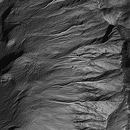Study suggests water may be flowing on Mars
San Diego Union Tribune
December 6, 2006
SAN DIEGO - Scientists have found what could be water flowing on Mars - now, not in the planet's distant past.
The startling discovery was made by comparing photographs of the same places on Mars between April 1999 and February 2004. The findings, led by researchers Mike Malin and Ken Edgett at Malin Space Science Systems in San Diego, were announced at a NASA press conference Wednesday in Washington D.C.
"You have all heard of a smoking gun?," Edgett said. "Mike Malin calls this a squirting gun."
If it's confirmed, the discovery of water flowing on the surface of Mars would be a huge finding. Liquid water is essential for life, and scientists hoping to find life elsewhere in the solar system have focused their search by first looking for water.
Much more work is needed, however, to confirm that the feature was created by flowing water, the scientists said.
One key step will be to conduct a spectrographic analysis to confirm conclusively that the feature was created by water flows. Another could be to someday visit the site or others like it with a future Mars rover.
"You cannot prove just from some images that it's water," Edgett said. "You can just make a case, based on everything you know about Mars right now."
Scientists made the finding during a photographic study of craters on the planet by the Mars Global Surveyor, a satellite orbiting the Red Planet since 1997. The study is being published this week in the journal Science. The Mars Global Surveyor carries high-tech cameras developed in San Diego by Malin Space Science Systems.
The apparent water flows they've seen are about a mile long, down a 20 to 30-degree slope on the walls of two craters.
NASA's Mars rovers, which have been exploring the planet's surface since they landed there in 2004, have found strong evidence that suggests that water flowed on the planet long ago.
"We've had this story of ancient Mars... (but) today we're talking about liquid water flowing on Mars right now," Edgett said.
"Clearly what Mike and Ken and their colleagues have provided are a remarkable set of new observations that show again, how dynamic and active the surface of Mars is," said Phil K. Christensen, a geologist at Arizona State University who joined the NASA press conference.
"The evidence for this recent water is compelling."
Mars orbits the sun at an average distance of 143 million miles, compared with 93 million miles for the Earth. It's an extremely cold place, with average temperatures at 81 degrees below zero.
The atmosphere, made mostly of carbon dioxide, is very thin so the air pressure at the surface is very low compared with Earth.
The potential water flows lie in craters in the planet's mid-latitudes, where temperatures can be much warmer than the average.
At the news conference, Malin described one way the flows could have been created:
Groundwater, rising to the surface, would likely immediately freeze into ice along the slope of the crater. Water coming up behind it would break the "dam" of ice on the slope, sending a mix of ice and rock cascading down the slope.
During upwellings that create these flows, the area may be shrouded in a mist of ice crystals, as water vapor at the surface freezes above the flow of ice and rock, Malin said.
On the surface, the flow might look a lot like a flash flood of mud and rock down an arroyo in the desert Southwest, Malin said.
The water might stay liquid at the surface because it's extremely acidic, Malin said. Water can become acidic by mixing with minerals in the ground, and acidic water has a lower freezing point than pure water.
Scientists don't know how the water stays heated underground, or where it's coming from in the first place, the scientists said.
But the observations suggest there is some kind of underground aquifer, snowpack or buried ice that is rising to the surface as liquid water and feeding these flows on the surface, they said.
"Today we can honestly talk about liquid water on Mars today," said Christensen. "That revolution in our thinking has certainly changed the way we think about Mars, and about how we should explore Mars."





 Share your thoughts in the Forum
Share your thoughts in the Forum
